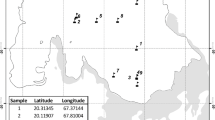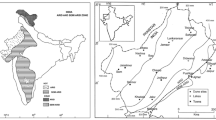Abstract
A bacterial phylogenetic survey of three environmentally distinct Antarctic Dry Valley soil biotopes showed a high proportion of so-called “uncultured” phylotypes, with a relatively low diversity of identifiable phylotypes. Cyanobacterial phylotypic signals were restricted to the high-altitude sample, whereas many of the identifiable phylotypes, such as the members of the Actinobacteria, were found at all sample sites. Although the presence of Cyanobacteria and Actinobacteria is consistent with previous culture-dependent studies of microbial diversity in Antarctic Dry Valley mineral soils, many phylotypes identified by 16S rDNA analysis were of groups that have not hitherto been cultured from Antarctic soils. The general belief that such “extreme” environments harbor a relatively low species diversity was supported by the calculation of diversity indices. The detection of a substantial number of uncultured bacterial phylotypes showing low BLAST identities (<95%) suggests that Antarctic Dry Valley mineral soils harbor a pool of novel psychrotrophic taxa.


Similar content being viewed by others
Explore related subjects
Discover the latest articles and news from researchers in related subjects, suggested using machine learning.References
Altschul, SF, Gish, W, Miller, W, Miers, EW, Lipman, DJ (1990) Basic logical alignment search tool. J Mol Biol 215: 403–410
Amann, RI, Ludwig, W, Schleifer, K-H (1995) Phylogenetic identification and in situ detection of individual microbial cells without cultivation. Microbiol Rev 59: 143–169
Barns, SM, Takala, SL, Kuske, CR (1999) Wide distribution and diversity of members of the bacterial kingdom Acidobacterium in the environment. Appl Environ Microbiol 65: 1731–1737
Basilio, A, Conzáles, I, Vicente, MF, Gorrochategui, J, Cabello, A, Gonzáles, A, Genilloud, O (2003) Patterns of antimicrobial activities from soil actinomycetes isolated under different conditions of pH and salinity. J Appl Microbiol 95: 814–823
Bunch, AW (1998) Biotransformation of nitriles by Rhodococci. Antonie Van Leeuwenhoek 74: 89–97
Cameron, R, Morelli, FA, Johnson, RM (1972) Bacterial species in soil and air of the Antarctic continent. Antarct J 187–189
Cameron, RE, King, J, David, C (1968) Soil microbial and ecological studies in Southern Victoria Land. Antarct J 121–123
Cameron, RE, King, J, David, CN (1970) Microbial ecology and microclimatology of soil sites in Dry Valleys of Southern Victoria Land, Antarctica. In: Holdgate, MW, (Ed.) Antarctic Ecology, 1. Academic Press, London, pp 702–716
Chandler, DP, Fredrickson, JK, Brockman, FJ (1997) Effect of PCR template concentration on the composition and distribution of total community 16S rDNA clone libraries. Mol Ecol 6: 475–482
Christner, BC, Kvitko, BH, Reeve, JN (2003) Molecular identification of bacteria and Eukarya inhabiting an Antarctic cryoconite hole. Extremophiles 7: 177–183
Cockell, CS, Stokes, MD (2004) Widespread colonization by polar hypolyths. Nature 431: 414
Cowan, DA, Russell, NJ, Mamais, A, Sheppard, DM (2002) Antarctic Dry Valley mineral soils contain unexpectedly high levels of microbial biomass. Extremophiles 6: 431–436
de la Torre, JR, Goebel, BM, Friedmann, EI, Pace, NR (2003) Microbial diversity of cryptoendolythic communities from the McMurdo Dry Valleys, Antarctica. Appl Environ Microbiol 69: 3858–3867
de los Ríos, A, Ascaso, C, Wierzchos, J, Fernández-Valiente, E, Quesada, A (2004) Microstructural characterization of cyanobacterial mats from the McMurdo ice shelf, Antarctica. Appl Environ Microbiol 70: 569–580
Dunbar, J, Barns, SM, Ticknor, LO, Kuske, CR (2002) Empirical and theoretical bacterial diversity in four Arizona soils. Appl Environ Microbiol 68: 3035–3045
Dunbar, J, Ticknor, LO, Kuske, CR (2000) Assessment of microbial diversity in four southwestern United States soils by 16S rRNA gene terminal restriction fragment analysis. Appl Environ Microbiol 66: 2943–2950
Farelly, V, Rainey, F, Stackebrandt, E (1995) Effect of genome size and rrn gene copy number on PCR amplification of 16S rRNA genes from a mixture of bacterial species. Appl Environ Microbiol 61: 2798–2801
Folch, J, Lees, M, Stanley, GHS (1957) A simple method for the isolation and purification of total lipids from animal tissues. J Biol Chem 266: 497–509
Friedmann, EI (1993) Antarctic Microbiology. Wiley-Liss. New York, pp 634
Hoeft, SE, Kulp, TR, Stolz, JF, Hollibaugh, JT, Oremland, RS (2004) Dissimilatory arsenate reduction with sulfide as electron donor: experiments with mono lake water and isolation of strain MLMS-1, a chemoautotrophic arsenate respirer. Appl Environ Microbiol 70: 2741–2747
Holmes, AJ, Bowyer, J, Holley, MP, O'Donoghue, M, Montgomery, MR, Gillings, MR (2000) Diverse, yet-to-be-cultured members of the Rubrobacter subdivision of the Actinobacteria are widespread in Australian arid soils. FEMS Microbiol Ecol 33: 111–120
Horne, AJ (1972) The ecology of nitrogen fixation on Signy Island, South Orkney Islands. Br Antarct Surv Bull 27: 1–18
Horowitz, NH, Cameron, RE, Hubbard, JS (1972) Microbiology of the Dry Valleys of Antarctica. Antarct Sci 176: 242–245
Hughes, JB, Hellmann, JJ, Ricketts, TH, Bohannan, BJM (2001) Counting the uncountable: statistical approaches to estimating microbial diversity. Appl Environ Microbiol 67: 4399–4406
Janssen, PH, Yates, PS, Grinton, BE, Taylor, PM, Sait, M (2002) Improved culturability of soil bacteria and isolation in pure culture of novel members of the Divisions Acidobacteria, Actinobacteria, Proteobacteria, and Verrucomicrobia. Appl Environ Microbiol 68: 2391–2396
Jorgensen, F, Hansen, OC, Stougaard, P (2001) High-efficiency synthesis of oligosaccharides with a truncated beta-galactosidase from Bifidobacterium bifidum. Appl Microbiol Biotechnol 57: 647–652
Kuske, CR, Barns, SM, Busch, JD (1997) Diverse uncultivated bacterial groups from soils of the arid southwestern United States that are present in many geographic regions. Appl Environ Microbiol 63: 3614–3621
Lipson, DA, Schmidt, SK (2004) Seasonal changes in an Alpine soil bacterial community in the Colorado Rocky mountains. Appl Environ Microbiol 70: 2867–2879
Maidak, BL, Cole, JR, Lilburn, TG, Parker, CT, Saxman, PR, Stredwick, JM, Garrity, GM, Li, B, Olsen, GJ, Pramanik, S, Schmidt, TM, Tiedje, JM (2000) The RDP (Ribosomal Database Project) continues. Nucleic Acids Res 28: 173–174
Martin-Laurent, F, Philippot, L, Hallet, S, Chaussod, R, Germon, JC, Soulas, G, Catroux, G, (2001) DNA extraction from soils: old bias for new microbial diversity analysis methods. Appl Environ Microbiol 67: 2354–2359
McDougald, D, Rice, SA, Weichart, D, Kjelleberg, S (1998) Nonculturability: adaptation or debilitation. FEMS Microbiol Ecol 25: 1–9
McKay, CP (1993) Relevance of Antarctic microbial ecosystems to exobiology. In: Freidmann, IE (Ed.) Antarctic Microbiology. Wiley-Liss, New York, pp 603–614
Miller, DN, Bryant, JE, Madsen, EL, Ghiorse, WC (1999) Evaluation and optimization of DNA extraction and purification procedures for soil and sediment samples. Appl Environ Microbiol 65: 4715–4724
Miller, SR, Bebout, BM (2004) Variation in sulfide tolerance of photosystem II in phylogenetically diverse cyanobacteria from sulfidic habitats. Appl Environ Microbiol 70: 736–744
Muyzer, G, de Waal, EC, Uitterlinden, AG (1993) Profiling of complex microbial populations by denaturing gradient gel electrophoresis analysis of polymerase chain reaction-amplified genes encoding for 16S rRNA. Appl Environ Microbiol 59: 695–700
Nienow, JA, Friedmann, EI (1993) Terrestrial lithophytic (rock) communities. In: Friedmann, EI (Ed.) Antarctic Microbiology. Wiley-Liss, New York, pp 343–412
Ovreås, L, Daae, FL, Torsvik, V, Rodriguez-Valera, F (2003) Characterization of microbial diversity in hypersaline environments by melting profiles and reassociation kinetics in combination with terminal restriction fragment length polymorphism (T-RFLP). Microbiol Ecol 46: 291–301
Pannewitz, S, Schlensog, M, Green, TG, Sancho, LG, Shroeter, B (2003) Are lichens active under snow in continental Antarctica? Oecologia 135: 30–38
Parker, BC, Wharton, RA (1985) Physiological ecology of blue green algal mats (modern stromatolites) in Antarctic oasis lakes. Arch Hydrobiol Alg Stud 38/39: 331–348
Priscu, JC, Fritsen, CH, Adams, EE, Giovannoni, SJ, Paerl, HW, McKay, CP, Doran, PT, Gordon, DA, Lanoil, BD, Pinckney, JL (1998) Perennial Antarctic lake ice: an oasis for life in a polar desert. Science 280: 2095–2098
Reysenbach, A-L, Pace, NR (1995) Reliable amplification of hyperthermophilic archaeal 16S rRNA genes by the polymerase chain reaction. In: Robb, FT, Place, AR (Eds.) Archaea: A Laboratory Manual—Thermophiles. Cold Spring Harbor Laboratory Press, Cold Spring Harbor, pp 101–107
Sinigalliano, CD, Kuhn, DN, Jones, RD, Guerrero, MA (2001) In situ reverse transcription to detect the cbbL gene and visualize RuBisCO in chemoautotrophic nitrifying bacteria. Lett Appl Microbiol 32: 388–393
Staley, JT, Gosink, JJ (1999) Poles apart: biodiversity and biogeography of sea ice bacteria. Annu Rev Microbiol 53: 189–215
Stevenson, BS, Eichorst, SA, Wertz, JT, Schmidt, TM, Breznak, JA (2004) New strategies for cultivation and detection of previously uncultured microbes. Appl Environ Microbiol 70: 4748–4755
Suzuki, MT, Giovannoni, SJ (1996) Bias caused by template annealing in the amplification of mixtures of 16S rRNA genes by PCR. Appl Environ Microbiol 62: 625–630
Taton, A, Grubisic, S, Brambilla, E, De Wit, R, Wilmotte, A (2003) Cyanobacterial diversity in natural and artificial microbial mats of Lake Fryxell (McMurdo Dry Valleys, Antarctica): a morphological and molecular approach. Appl Environ Microbiol 69: 5157–5169
Torsvik, V, Goksøyr, J, Daae, FL (1990) High diversity in DNA of soil bacteria. Appl Environ Microbiol 56: 782–787
Vincent, WF (1988) Microbial ecosystems of Antarctica. Cambridge University Press, Cambridge
Vincent, WF, Howard-Williams, C, Broady, PA (1993) Microbial communities and processes in Antarctic flowing waters. In: Friedmann, EI (Ed.) Antarctic Microbiology. Wiley-Liss, Inc. New York, pp 543–569
Vishniac, HS (1993) The microbiology of Antarctic soils. In: Friedmann, HS (Ed.) Antarctic Microbiology. Wiley-Liss, New York, pp 297–341
Wakefield, D (1971) Mummified seals of southern Victoria Land. Antarc J U S 6: 210–211
Watanabe, K, Teramoto, M, Futamata, H, Harayama, S (1998) Molecular detection, isolation, and physiological characterization of functionally dominant phenol-degrading bacteria in activated sludge. Appl Environ Microbiol 64: 4396–4402
Waterbury, JB, Watson, SW, Guillard, RRL, Brand, LE (1979) Widespread occurrence of a unicellular, marine, planktonic cyanobacterium. Nature 277: 293–294
Wynn-Williams, DD (1990) Ecological aspects of Antarctic microbiology. In: Marshall KC (Ed.) Advances in Microbial Ecology, Vol. 2. Plenum Publishing, pp 71–146
Acknowledgments
This work was performed under the auspices of the Waikato University Antarctic Terrestrial Biology program. The authors wish to thank the University of Waikato, Antarctica New Zealand and the National Research Foundation of South Africa for financial support.
Author information
Authors and Affiliations
Corresponding author
Rights and permissions
About this article
Cite this article
Smith, J.J., Tow, L.A., Stafford, W. et al. Bacterial Diversity in Three Different Antarctic Cold Desert Mineral Soils. Microb Ecol 51, 413–421 (2006). https://doi.org/10.1007/s00248-006-9022-3
Received:
Accepted:
Published:
Issue Date:
DOI: https://doi.org/10.1007/s00248-006-9022-3




